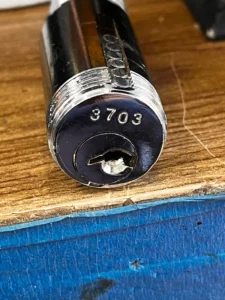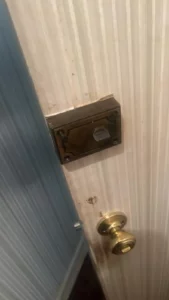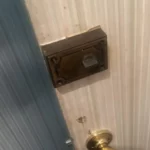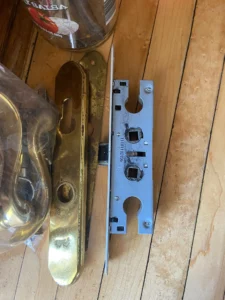Faulty Lock Mechanisms: Common Issues And Fixes

The experienced locksmith team at Real Time Locksmith understands common door lock problems and how to address them. We have years of experience and use all the right tools to help you maintain a secure environment and prevent future door lock problems.
The Top Common Door Lock Problems
A faulty locking mechanism can cause several issues that compromise their functionality and security. Common door lock problems include:
- A misaligned door latch and strike plate.
- Stuck or broken keys.
- Distorted door frames.
- Stuck deadbolts.
- Misaligned lock mechanisms.
- Frozen locks.
- General wear and tear.
Identifying the root cause of these issues is crucial for implementing practical solutions and restoring the functionality of your doors and locks. This article will point out the most common door lock problems you could face with your locking mechanism and ways to resolve them. If you are unsure how to resolve these issues, call a locksmith like Real Time before causing even more damage to your locks and doors. The professional help we offer can save you time, money, and frustration.
#1. A Misalignment in the Door Latch
An off-center latch system can prevent doors from closing or locking correctly, compromising the security of your property. This issue often occurs due to loose screws, worn-out hinges, or changes in the door frame caused by shifting foundations or temperature fluctuations.
To fix an improperly aligned latch, tighten the screws, adjust the hinges, or realign the strike plate to ensure proper alignment and smooth operation of the lock.
#2. Stuck and Broken Keys
Stuck or broken keys are a common issue preventing you from unlocking or locking your doors. This problem may occur due to key wear, debris accumulation in the lock cylinder, or a faulty keyway. To resolve this issue, try lubricating the key and lock cylinder with graphite powder or a silicone-based lubricant.
If you’re dealing with a stuck key, avoid applying excessive force, which can further damage the internal components of the lock system. Carefully remove the broken piece using needle-nose pliers in cases of a broken key.
#3. Distorted Door Frame
A distorted door frame can cause doors to bind or stick, making it difficult to open or close. This issue may result from moisture damage, structural settling, or improper installation.
To fix a distorted door frame, you may need to adjust the hinges, reinforce the frame with shims or filler material, or replace damaged components. Properly maintaining and sealing the door frame can also help prevent future distortion and ensure the smooth operation of your door lock.
#4. Stuck Deadbolts
A deadbolt lock that won’t budge can pose a significant risk to you, your family, your business, and your property, as it prevents the door from locking or unlocking correctly. This issue may occur due to debris accumulation, foreign objects in the path of the locks, misalignment, or internal lock failure.
To resolve a stuck bolt, lubricate the bolt with a penetrating oil and gently tap it with a hammer to free any stuck components. If the deadbolt remains stuck, you may need to disassemble the lock system and inspect for damaged parts or obstructions. You may have to replace the lock if the deadbolt has suffered irreparable damage.
#5. Misaligned Door Lock
An improperly aligned door lock can cause difficulty turning the key or operating the lock system. This problem often occurs due to loose screws, worn-out components, or improper installation. The best solution to fix an improperly aligned door lock is to tighten loose screws. Making minor adjustments to the strike plate or latch system will also ensure the lock is properly aligned with the keyway.
If the issue persists, consider replacing worn-out components or seeking assistance from a professional locksmith like Real Time Locksmith. As your local locksmith, we can assist with misaligned locks and help unlock your doors immediately!
#6. Frozen Door Lock
A frozen lock is a common problem in winter, especially in regions with cold climates. This issue occurs when moisture accumulates in the lock system and freezes, preventing the key from turning.
To thaw a frozen lock, gently heat the key with a lighter or hairdryer and insert it into the cylinder to melt the ice. Avoid using excessive force with the key to prevent damage to the lock system. A commercial de-icing spray or graphite lubricant can also help prevent future freezing.
If your key breaks off into a frozen lock, call our professional locksmith team. With a quick look, we’ll know exactly how to fix the problem. We can also cut a new key on the spot and get your lock working perfectly again. With the right key and the right lock system, you’ll be able to unlock and lock your door easily.
#7. Wear and Tear
General wear and tear can significantly affect the performance and longevity of locks over time. Components such as springs, pins, and cylinders may become worn or damaged, leading to difficulty turning the key, sticking or jamming, and decreased property protection. Even using the wrong key in the wrong position by mistake can cause severe problems for your lock.
Regular maintenance on your locks can help prolong their lifespan and prevent potential problems and the need to install a new lock. It includes lubricating moving parts and inspecting for signs of wear.
How to Fix Common Door Lock Problems
Fixing a faulty lock system requires careful diagnosis and troubleshooting to identify the issue’s underlying cause. Depending on the specific problem, you may need to call our team of locksmiths to perform various repair techniques to restore your locks’ functionality. Here are some common steps we employ for fixing a faulty lock:
Remove the Door Handle or Knob
The first thing we do is remove the door handle or knob to access the lock. We use a screwdriver to loosen the screws securing the handle or knob to the door and carefully remove it. We may need to position the door handle or knob again so that it aligns properly each time you turn the door or use your key.
Reposition the Door Locks
Inspect the cylinder for signs of misalignment or damage. If the cylinder doesn’t line up correctly, we use a screwdriver to adjust the mounting screws and reposition it accordingly. We ensure that the cylinder is aligned with the keyway and operates smoothly before reassembling the door handle or knob.home
Replace Broken Parts
If the lock system is damaged or worn out, we may need to replace broken parts to restore functionality. Typical components that may require replacement include springs, pins, and cylinders. We carry top-of-the-line replacement parts and always follow manufacturer guidelines to install the new parts properly.
DIY vs. Hiring a Locksmith to Fix a Faulty Lock Mechanism

Our professional locksmith team has the experience and training to diagnose and repair a wide range of lock problems efficiently and effectively. Hiring our locksmith team ensures that the issue is addressed correctly the first time, reducing the risk of further damage or security breaches. Our locksmiths can also provide expert advice on maintenance practices and security upgrades to enhance the longevity and security of your locks.
Conclusion
Maintaining functional and secure door locks is essential for the safety and security of your home or business. We understand common issues with door locks, such as misalignment parts, stuck keys, and wear and tear, and can point out potential problems before they escalate.
By implementing proper maintenance practices and knowing when to seek the professional assistance of Real Time Locksmith, you can ensure that your door locks remain a reliable and effective way to protect your property against unauthorized access and security threats.



